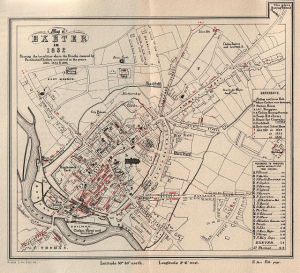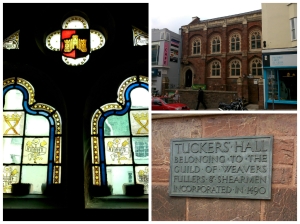Unexplored Exeter for Heritage Open Days 2014
The European Heritage Days (Journées européennes du patrimoine) initiative was created by the Council of Europe and the European Commission in 1991 in order to raise awareness and to promote the cultural wealth of Europe, with the key caveat that all events, open days, and talks must be free to attend. Now with 50 signatory states participating, the EHD have wider-reaching aims, including in 2014 to:
- raise the awareness of European citizens to the richness and cultural diversity of Europe;
- create a climate in which the appreciation of the rich mosaic of European cultures is stimulated;
- counter racism and xenophobia and encourage greater tolerance in Europe and beyond the national borders;
- inform the public and the political authorities about the need to protect cultural heritage against new threats;
- invite Europe to respond to the social, political and economic challenges it faces.
(Council of Europe and European Union 2014, http://pjp-eu.coe.int/en/web/ehd-jep/presentation)

Map of the city of Exeter from 1832. The Roman baths lie under the green in front of the Cathedral, rough in the centre between the letters R and L. Used under CC SA 3.0 license from Plymouth University
The English branch of the programme, called Heritage Open Days, celebrates its 20th anniversary this year, taking place between 11th and 14th September 2014. I visited several sites over the weekend portion of the open days in my home city of Exeter. Exeter is possibly most well-known as the site of a Roman legionary fortress and subsequent province, Isca Dumnoniorum. Built over the Roman civic centre (and at the heart of the modern city centre) is the large gothic Cathedral of St. Peter. It was a talk discussing this very site by the Devon Archaeological Society that was the first Heritage Open Days event I attended this year. This talk presented the (continuing) history of the Roman Baths of Exeter, excavated in 1972/3 and subsequently recovered with sand. The key issue with the site is that the mid-1st century AD Legionary baths lie under both the Cathedral Green, a 1970’s processional stairway listed by English Heritage, and adjacent buildings in the Cathedral Close. In order to expose the Roman Baths, at least part of the listed steps would have to destroyed, a WWII memorial rehomed, and a large portion of the landscaped Cathedral Green dug up. In the 40 years since excavation, various schemes have been put forward, yet so far none have seen fruition, with funding or feasibility being the main stumbling blocks. Last year the idea was reignited with the key stakeholder, the Diocese of Exeter, prepared to discuss the possibility of exposing the baths. The key issues (that have existed from when the site was excavated 40 years’ previously) continue to be the location and how the re-excavation and exposure would work architecturally, the funding for such a large project, and the site’s ongoing conservation (Allan 2014, 3). Such a large and historically interesting site and interpretation centre would bring many tourists, visitors and educational groups to the city, and this factor has been cited (with reference to the success of the Roman bath house at Bath) as one of the reasons to finally make the project a reality.
I also attended open days at sites not often (in one case not at all until now) open to the public. These included Tuckers Hall and the Dissenter’s Graveyard. The former is a guild hall built in the mid-1400s for weavers, tuckers and shearmen during the city’s booming wool trade. The building has managed to survive, tucked away on one of the main roads in the city centre and surviving for hundreds of years through the collapse of the wool trade in the city, infrastructural changes, renovation and even the extensive Luftwaffe bombing of the city during WWII. Now a Grade II* listed building, it is still owned and managed by the Incorporation of Weavers, Fullers and Shearmen, and open to the public on selected days. Upon entering the building, I immediately regretted not visiting sooner, as it has a great exhibition of the history of wool trading in Exeter, the wool making process and evidence of the ubiquity of wool working in the city prior to the industrial revolution. The recent development project that enabled this interpretation centre to be built is not quite finished; the Guild are also looking to digitise their extensive archive of documents dating back to the 16th century.
The Dissenter’s Graveyard is a heritage site that was little-known, if not unknown, in the city until the beginning of this year when it was purchased by the trust that now owns and manages it. Created in the mid-1700s, the purpose of the graveyard was to be the final resting place of protestant non-conformists who disagreed with the Anglican faith (hence ‘dissenters’). Full-up within around 100 years, the small plot is the site of up to 2,000 burials. The Exeter Dissenters Graveyard Trust has now de-weeded and cleaned up the tombstones in the first phase of a project funded by the Heritage Lottery Fund, the Council for British Archaeology and private donation. From my visit during Heritage Open Days it was clear that the project’s success has relied on the mobilisation of volunteers who have worked to preserve this site in partnership with the trust and funders. Volunteers and organisations working in partnership was discussed at other sites I visited during the weekend; evidencing both the eagerness of the local community to protect Exeter’s heritage, but also the European Heritage Days aim of inform(ing) the public and the political authorities about the need to protect cultural heritage against new threats, as to many sites a lack of personnel is a continued threat.
References
Allan, J. 2014. ‘Exeter’s Roman legionary Bath-house’ in Devon Archaeological Society Newsletter. No.117, January 2014. Exeter: Devon Archaeological Society
 Carmen Talbot is a student in the 2013 cohort of the Heritage Management MA, and Kent Scholar. Previously studying Ancient History as an undergraduate, she is interested in adult education in heritage and encouraging the wider adoption of digital solutions.
Carmen Talbot is a student in the 2013 cohort of the Heritage Management MA, and Kent Scholar. Previously studying Ancient History as an undergraduate, she is interested in adult education in heritage and encouraging the wider adoption of digital solutions.

